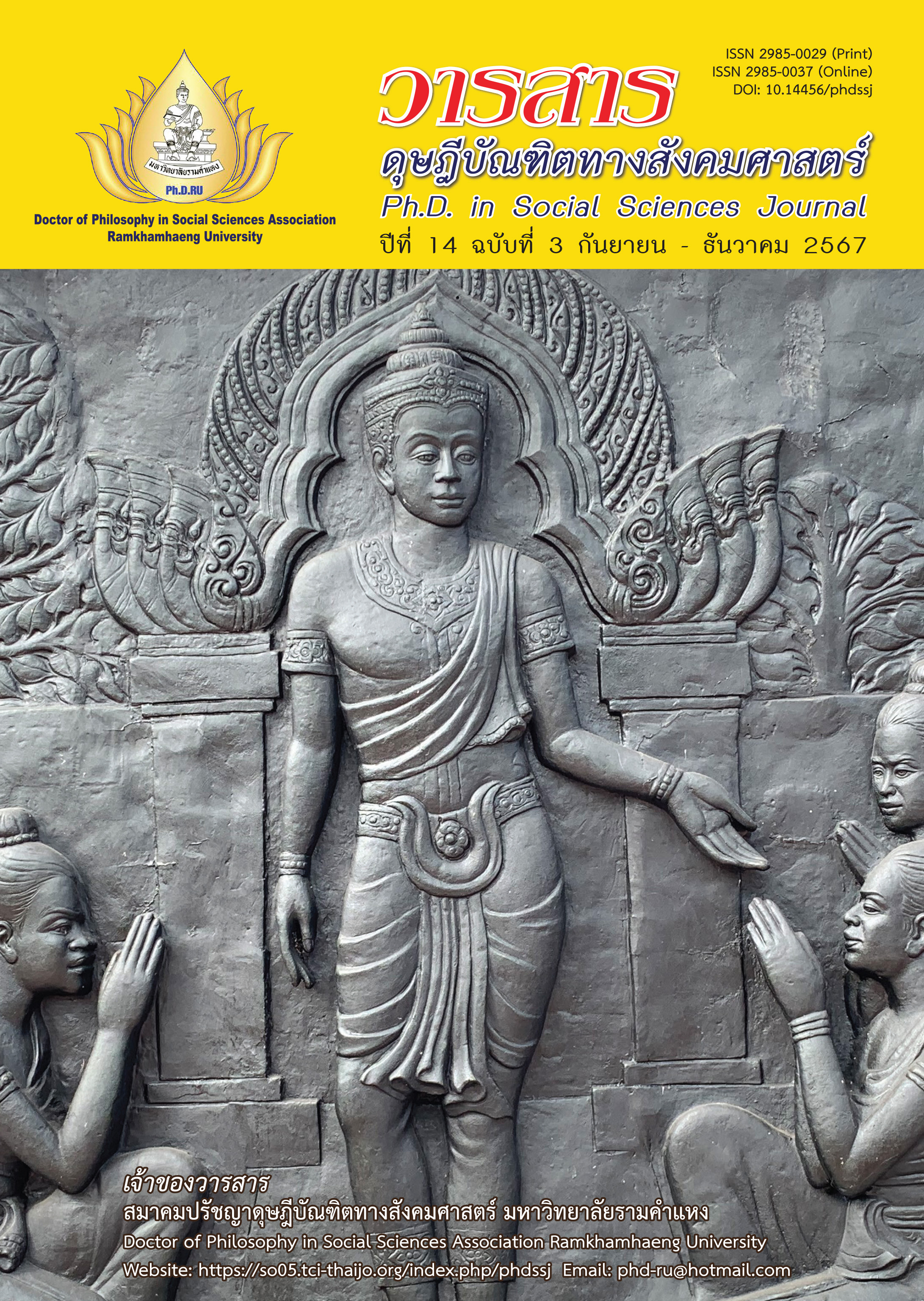Inclusive Leadership, Work Engagement and Adaptive Performance of Dept Collector in Thailand
Main Article Content
Abstract
This research article aims to study (1) the level of inclusive leadership, work engagement, and adaptive performance of debt collectors, (2) the influence of inclusive leadership on the adaptive performance of debt collectors, and (3) the influence of work engagement on the adaptive performance of debt collectors. This study is a quantitative research. Data were collected from a sample group of 252 debt collection company employees from 3,483 companies. The research instrument was a questionnaire. The statistics used to analyze the data were mean, standard deviation and structural equation modeling analysis.
Findings are as follows: the inclusive leadership of debt collection company executives the work engagement and adaptive performance, the overall level was a high level. The inclusive leadership has a low direct influence on adaptive performance with a path coefficient of 0.227, and work engagement has a direct influence on adaptive performance of debt collectors at a moderate level, with a path coefficient of 0.641, which was statistically significant at the .01 level. The result was indicated that work engagement was the prominent predictor adaptive performance of debt collectors, while inclusive leadership could be utilized in conjunction to enhance contextual adaptability.
Article Details

This work is licensed under a Creative Commons Attribution-NonCommercial-NoDerivatives 4.0 International License.
Academic articles, research articles, and book reviews in the Ph.D. in Social Sciences Journal are author’s opinions, and not the publisher’s, and is not the responsibility of the Ph.D. in Social Sciences Journal Philosophy Association, Ramkhamhaeng University. (In the case that research is done on human, the researcher has to be trained in Ethics for Doing Research on Human Training and has to produce the evidence of the training).
References
Abdullahi, M. S., Raman, K., Solarin, S. A., & Adeiza, A. (2023). Employee engagement as a mediating variable on the relationship between employee relation practice and employee performance in a developing economy. Journal of Applied Research in Higher Education, 15(1), 83-97.
Adkin, D. A., Davis, S. S., Sparrow, R. A., Huckle, P. D., & Wilding, I. R. (1995). The effect of mannitol on the oral bioavailability of cimetidine. Journal of Pharmaceutical Sciences, 84(12), 1405-1409.
Allen, N., & Meyer, J. (1990). Organizational socialization tactics: A longitudinal analysis of links to newcomers’ commitment and role orientation. Academy of Management Journal, 33(4), 847-858.
Ashikali, T. (2019). Leading towards inclusiveness: Developing a measurement instrument for inclusive leadership. Retrieved from https://journals.aom.org/doi/10.5465/AMBPP.2019.16444abstract
Bakker, A. B., Demerouti, E., & Schaufeli, W. B. (2002). Validation of the Maslach burnout inventory-general survey: An internet study. Anxiety, Stress and Coping, 15(3), 245-260.
Bollen, K. A. (2014). Structural equations with latent variables. John Wiley & Sons.
Carlson, J. A. (2010). Avoiding traps in member checking. The Qualitative Report, 15(5), 1102-1113.
Carmeli, A., Reiter-Palmon, R., & Ziv, E. (2010). Inclusive leadership and employee involvement in creative tasks in the workplace: The mediating role of psychological safety. Creativity Research Journal, 22(3), 250-260.
Chaiwuttisak, P. (2023). A trend forecasting model of daily Euro/USD exchange rate using sentiment analysis on online news. The Journal of King Mongkut’s University of Technology North Bangkok, 33(4), 1-14. [In Thai]
Charbonnier-Voirin, A., & Roussel, P. (2012). Adaptive performance: A new scale to measure individual performance in organizations. Canadian Journal of Administrative Sciences, 29(3), 280-293.
Choi, S. B., Tran, T. B. H., & Park, B. I. (2015). Inclusive leadership and work engagement: Mediating roles of affective organizational commitment and creativity. Social Behavior and Personality: An International Journal, 43(6), 931-943.
Coleman, J. S., Hoffer, T., & Kilgore, S. (1981). Public and private schools. ERIC.
Department of Provincial Administration, Investigation and Legal Affairs Bureau. (2019). Information of debt collection business registrants. Retrieved from https://multi.dopa.go.th/ilab/official_letter/cate8 [In Thai]
Diamantopoulos, A., & Siguaw, J. A. (2000). Introducing LISREL. Sage.
Griffin, B., & Hesketh, B. (2003). Adaptable behaviours for successful work and career adjustment. Australian Journal of Psychology, 55(2), 65-73.
Hollander, E. (2012). Inclusive leadership: The essential leader-follower relationship. Routledge.
Hulin, C. (1991). Adaptation, persistence, and commitment in organizations. In M. D. Dunnette & L. M. Hough (Eds.), Handbook of industrial and organizational psychology (pp. 445–505). Consulting Psychologists Press.
Koekemoer, L., De Beer, L. T., Govender, K., & Brouwers, M. (2021). Leadership behaviour, team effectiveness, technological flexibility, work engagement and performance during COVID-19 lockdown: An exploratory study. SA Journal of Industrial Psychology, 47(1), 1-8.
Lance, C. E., Vandenberg, R. J., & Self, R. M. (2000). Latent growth models of individual change: The case of newcomer adjustment. Organizational Behavior and Human Decision Processes, 83(1), 107-140.
Mondy, R. W., & Martocchio, J. J. (2016). Human resource management (14th ed.). Pearson.
Moss, G., Sims, C., Dodds, I., & David, A. (2016). Inclusive leadership: Boosting engagement, productivity and organisational diversity. Equal Opportunities Review, 268, 5-8.
Pulakos, E. D., Arad, S., Donovan, M. A., & Plamondon, K. E. (2019). Adaptability in the workplace: Development of a taxonomy of adaptive performance. Journal of Applied Psychology, 85(4), 612-624.
Rachawangmoung, R. (2020). Legal problems regarding debt collection at the disadvantage of creditors. Retrieved from http://www.lawgrad.ru.ac.th/Abstracts/975 [In Thai]
Schaufeli, W. B., Bakker, A. B., & Salanova, M. (2006). The measurement of work engagement with a short questionnaire: A cross-national study. Educational and Psychological Measurement, 66(4), 701-716.
Schumacker, R. E., & Lomax, R. G. (2010). A beginner’s guide to structural equation modelling (3rd ed.). Routledge.


